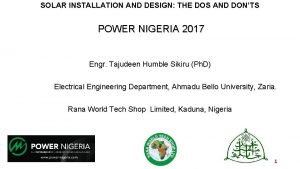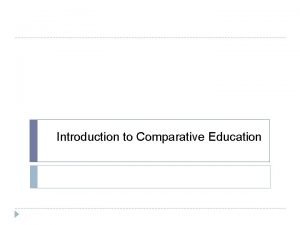Comparative Analysis of Microstructural Defects in Monocrystalline Copper

- Slides: 1

Comparative Analysis of Microstructural Defects in Monocrystalline Copper: Shock Compression Versus Quasi-isentropic Compression H. Jarmakani, M. Meyers, M. Schneider, B. Cao and B. Kad, Materials Science and Engineering, UCSD, La Jolla, CA. Mc Naney, J Nguyen, and D. Orilkowsi, Lawrence Livermore National Laboratory, Livermore, CA. OBJECTIVES: • Understanding deformation mechanisms of [001] Cu under various high-pressure and high-strain rate loading conditions. • Microstructural characterization. • Develop constitutive models to determine slip-twinning transition in Quasi-ICE and shock compression. Shock: Instantaneous loading. Quasi-ICE: Controlled “ramped” loading. TWINNING THRESHOLD MODELING QUASI-ICE VS. SHOCK • The Prenston-Tonks-Wallace (PTW) constitutive description is used to determine critical twinning pressure in both shock and quasi-isentropic conditions. • PTW equation takes into account both thermal activation regime and dislocation drag regimes. • The instantaneous flow stress is given by: Slices cut from cylindrical samples Cell size vs. pressure: quasi-ICE, laser shock and flyer-plate Where and are work hardening saturation stress and yield stress, respectively. is the value of taken at zero temperature, , θ are the strain and work hardening rate, respectively, and p is a dimensionless material parameter. Dislocation cell size vs. distance from sample free surface: Gas-gun ICE Strong Shock Regime Thermal Activation Regime Strain-rate regimes in shock and Quasi ICE -Gas-Gun • Flow stress is normalized to shear modulus and twinning threshold assumed to vary with pressure: Source: M. Pullington et al. , Discovery. DYNAMIC COMPRESSION METHOD EXPERIMENTAL SETUP Temperature rise in shock and ICE (gas-gun) PRESSURE PROFILES Hardness, Temp. vs. Peak Pressure: Gas-gun quasi-ice Dislocation sell size vs. distance from sample free surface: Laser shock TRANSMISSION ELECTRON MICROSCOPY (TEM) OF KEY FEARURES AT: 50 -60 GPA Twinning at 52 GPa 30 -40 GPA Dislocated laths at 34 GPa 15 -30 GPA Stacking faults at 26 GPa GAS-GUN QUASI-ICE Flow stress vs. peak pressure: gas-gun modeling ~104 s-1 Flow stress vs. peak pressure: laser modeling CONCLUSIONS AND FUTURE WORK Twins/laths at 59 GPa Dislocation cells and stacking faults at 24 GPa Dislocation cells at 18 GPa LASER QUASI-ICE ~107 s-1 Micro-twins at 57 GPa Stacking faults at 30 GPa FLYER PLATE IMPACT (Experimental data unavailable) ~104 s-1 Micro-twins at 55 GPa Staking faults at 40 GPa • Dislocation activity decreased away from impact surface in all cases. • TEM revealed twinning at higher pressures, stacking faults and dislocated laths at intermediate pressures and mostly dislocation cells at relatively lower pressures. • Modeling revealed twinning threshold lower for higherstrain rate compression experiments and reasonable agreement with experimental data. • Future work will incorporate nanocrystalline materials (e. g. nc Ni and nc Ni%Fe). • Understanding deformation mechanisms in nc materials: • Dislocation interactions with grain boundaries. • Grain boundary sliding. • Pressure effects on hardness. • Twinning thresholds modeling. • Molecular dynamics (MD), specifically LAMMPS, will be used to simulate and study shock and high-strain-rate phenomena in nc materials and compare with experiments. • High strain rate phenomena in bulk metallic glasses (BMGs) will also be integrated into study. Dislocation cells at 20 GPa ACKNOWLEDGEMENT: LASER SHOCK ~109 s-1 This work was performed under the auspices of the U. S. Department of Energy by University of California, Lawrence Livermore National Laboratory.

